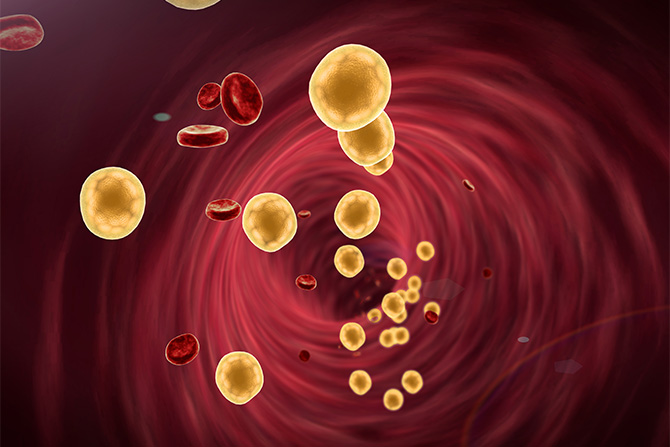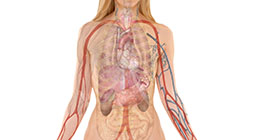
Overview
Symptoms
Causes
Prescription
Health Tips
Despite the resources spent educating the North American public about the dangers of a diet high in fat and high cholesterol foods contributing to cardiovascular problems, heart disease is still the number one cause of death in adults. Yet simple modifications to diet and lifestyle could prevent a majority of fatalities.
According to both the American Heart Association and the Canadian Heart and Lung Association, 40 percent of the adult population has high cholesterol levels, the leading risk factor for heart disease. However, more attention is beginning to focus on the role of high triglyceride levels as a better predictor of heart attack risk.
Cholesterol has a bad reputation, yet the fact is cholesterol is essential to health. It allows the body to make repairs, insulate nerves, form cell membranes, and produce certain sex hormones such as testosterone and estrogen. Cholesterol is in many of the foods consumed and is also produced in the liver and intestines.
LDL and HDL
There are two types of cholesterol: low-density lipoprotein (LDL) cholesterol, known as the “bad” cholesterol and high-density lipoprotein (HDL) cholesterol, the “good” cholesterol. LDL carries cholesterol and triglycerides from the liver to the cells, whereas HDL can absorb LDL and carry it away from the cells.
Most people have a feedback mechanism that moderates their cholesterol levels. If one consumes too much cholesterol the liver makes less, and if consuming too little the liver makes more. For some, however, cholesterol levels must be maintained by making simple changes in the diet and taking nutritional supplements. Although there are many warnings about high cholesterol, many are not aware that very low levels of cholesterol can be an indicator of other health concerns. Cholesterol levels below the normal range are often associated with cancer. Low cholesterol is also common in those who are very thin and rarely exercise.
When there is too much LDL in the blood, plaque slowly accumulates on the blood vessel walls. The arteries become narrower and the heart must work harder to pump blood to the body; the blood and oxygen cannot reach the heart leading to pain in the chest (angina). With narrower arteries, a small piece of debris, such as a blood clot, can completely obstruct the artery and cause a heart attack.
HDL cholesterol is the “good” cholesterol because it transports LDL cholesterol away from the cells and back to the liver, thus preventing the arteries from hardening. HDL is also responsible for breaking down cholesterol into fatty acids, which are essential for strong cell membranes.
Triglycerides
Triglyceride levels are a better predictor of heart disease than high cholesterol. Triglycerides are the most prevalent type of fat existing in the body, and when present in excess may damage the arteries by encouraging arteriosclerosis. The perfect level for triglycerides would be 140 mg/dL (milligrams per deciliter), but 140–160 mg/dL is considered normal.
Symptoms
Symptoms may include angina or chest pain. A fatty tissue buildup under the skin, especially on the eyelids, indicates poor cholesterol metabolism. In severe cases pain in the legs may occur when walking.
The following are the accepted guidelines for determining level of risk.
| Total Cholesterol: | LDL: |
| Desirable: less than 200 mg/dL | Desirable: less than 130 mg/dL |
| Borderline to high: 200–239 mg/dL | Borderline to high: 130–159 mg/dL |
| High: 240 mg/dL or higher | High: 160 mg/dL or higher |
| HDL: Higher than 35 mg/dL | Triglycerides: Less than 150 mg/dL |
Causes
High cholesterol is largely a product of poor habits. Consuming a diet that is high in bad fats, specifically artificial trans fats will increase LDL and inflammation in the body. Both of these contribute to heart disease and stroke as well as other conditions including diabetes and high blood pressure. Refined carbohydrates which are low in fiber, and insufficient amounts of fresh fruits and vegetables are also a main part of the problem as this increases oxidative stress in the body. Excessive stress, a sedentary lifestyle, smoking, and genetic predisposition compound the problem. Hypothyroidism has also been linked to high cholesterol and whether clinical or subclinical if hypothyroidism is the instigator, low-cholesterol diets and supplements to lower cholesterol will have no effect on cholesterol levels.
Dietary vs. Blood Cholesterol
It is often reported that eating eggs should be avoided because they are a “high cholesterol” food. This advice stems from a misunderstanding about the difference between dietary cholesterol and blood cholesterol. Dietary cholesterol is obtained from certain foods, whereas blood cholesterol is manufactured by the body and found in the bloodstream. However, eating foods containing dietary cholesterol will not necessarily put cholesterol into the bloodstream. The liver makes blood cholesterol from fats, sugars, and proteins. Diets high in processed foods, refined oils and sugars increase cholesterol production. Free radical damage also causes the body to produce more cholesterol. This is because the body uses cholesterol to repair damaged cells, tissues and organs.
Studies show that eggs will not increase cholesterol levels but in fact may actually help lower them. Eggs contain lecithin which emulsifies the cholesterol in them. Homogenized milk does more damage to arteries than eggs ever will because the fat globules in it have been mechanically altered to such a small state that they can be absorbed directly into the bloodstream.
A low-glycemic, unprocessed, healthy-fat diet is key to cholesterol reduction. Fiber is absolutely critical as it binds onto excess cholesterol and helps eliminate it before it is absorbed.
Prescription for Health
Diet
Carbohydrates – Adopt the simple rule of not eating any white foods; white sugar, white flour, white pasta, white rice, white potatoes, etc. Avoid all processed foods. Processed foods contain sugars, trans-fatty acids and refined carbohydrates which take only a few minutes to cause a rapid increase in blood sugar and a corresponding release of insulin. It is better to eat a complex or non-refined carbohydrate which can take hours to convert to glucose. Grains in their whole form make great breakfast porridges and work well in savoury meals as a rice replacement. The foods below increase the amount of fiber in the diet which is important for diabetics.
Include:
- Brown rice
- Buckwheat
- Millet
- Quinoa
- Steel cut oats or whole oat groats
- Whole grain pastas
Fats – Avoid sources of poor-quality saturated fats such as deep-fried foods (chips, crackers, doughnuts), margarine, poor quality oils (canola, safflower, sunflower, peanut and soy oils), hydrogenated and trans fats. Research published in the American Journal of Clinical Nutrition stated that women eating a diet high in trans-fatty acids have an increased risk of developing diabetes. Reduce consumption of cheese and red meats. To increase intake of EPA and DHA, add regular servings of fishes such as salmon, herring or mackerel. Insulin levels normalize or decrease when saturated fats (the bad ones) are replaced with essential fats from quality sources.
Include:
- Avocado oil
- Borage oil (do not heat)
- Coconut oil
- Extra virgin olive oil
- Flax oil (do not heat)
- Grass-fed butter or ghee
Protein – Avoid or greatly reduce processed meats such as hot dogs and bologna. Aside from increasing cancer risk, research has shown that eating processed meats five or more times per week is a risk factor for developing diabetes. Eat small amounts of protein throughout the day. Protein, when consumed in small amounts, inhibits the rise of glucose and stimulates glucagon to release stored carbohydrates in the liver. However, too much protein has been shown to increase insulin, especially when consumed with certain types of carbohydrates. When simple, refined carbohydrates are combined with too much protein—for example, the burger with the white bun—insulin increases. Consume good protein sources with excellent carbohydrate sources low on the glycemic index while adding good fats and avoiding sugars.
Include:
- Nuts and seeds
- Organic, free-range chicken and eggs
- Organic, pasture-raised beef in small quantities
- Wild fish (Mackerel, sardines, anchovies, salmon)
Dairy – Avoid low-fat, skim milk and fruit yogurts as they are high in carbohydrates. The following organic, grass-fed items are okay in moderation for those not sensitive to dairy:
- Butter or ghee
- Goat’s milk, cheese, or butter
- Plain sugar-free, whole milk yogurt
Vegetables and fruit – Eat brightly coloured fruits and vegetables because they are high in vitamins and minerals and low on the glycemic index. Regular consumption of fruits and vegetables helps reduce the risk of developing diabetes. The Finnish Diabetes Prevention Study Group found that lifestyle modifications using diet and exercise reduced the incidence of diabetes in high-risk men and women by almost 60 percent. In addition, include lots of vegetables, especially the cruciferous vegetables (cauliflower, cabbage, broccoli, Brussels sprouts) and plant foods that encourage healthy liver function such as artichokes, rhubarb, Chinese white radish, black radish, apples, and rolled oats. Eat two eight-inch raw carrots per day, as this has been shown to reduce cholesterol by 50 points in a matter of weeks.
Sweeteners – Eliminate artificial sweeteners (aspartame, saccharine, sucralose) and use stevia which contains no sugars and has zero calories. Stevia has been shown to have a positive effect on the pancreas. Xylitol (which has been researched to prevent periodontal disease) is another sweetening option for those with high cholesterol and diabetes.
Lifestyle
Increasing HDL blood cholesterol while reducing LDL and triglycerides can have a profound effect on risk of heart disease and stroke. The Heart and Stroke Foundation has stated, “For every 1 percent drop in LDL cholesterol a 2 percent reduction in risk of heart attack occurs, and for every 1 percent increase in HDL levels the risk of heart attack drops 3 to 4 percent.” By following a healthy diet, taking supplements, and making a few modifications to lifestyle, one can prevent or delay the need for cholesterol-lowering medication.
Supplementation
If on Coumadin or statin cholesterol lowering medication, consult a naturopathic or medical doctor before embarking on this protocol. The following tips will lower cholesterol in less than 90 days in most cases, and going forward, one’s medications may then need to be reviewed and adjusted accordingly.
| NUTRIENT | DOSAGE | ACTION |
| Sytrinol | 300 mg daily with food | Lowers cholesterol and triglycerides in 30 days; improves LDL:HDL cholesterol ratio; a powerful antioxidant and anti-inflammatory that protects the arteries |
| Red yeast rice | 1800 mg | Contains natural statin called Monacolin-K. Lowers total cholesterol, LDL and triglycerides while increasing good HDL cholesterol without muscle pain of prescription statins. LDL decreased by more than 35 mg/dL |
| Inositol hexanicotinate (non flushing niacin) | 500–1000 mg three times daily with meals. If using plain flushing niacin, increase dosage slowly over three weeks until using 3000 mg daily to avoid the harmless flushing of the skin. | Lowers LDL cholesterol and triglycerides while raising HDL cholesterol. Have liver enzymes and cholesterol checked every three months if using flushing niacin. |
| Vitamin B5, pantethine | 300 mg three times daily | Lowers LDL and triglycerides and raises HDL |
| Phytosterols | 1–2 g of plant sterol daily | Plant sterols fill the receptor sites in the small intestine and reduce the absorption of cholesterol. Do not eat sterol-enriched margarines. |
| Omega-3 | 1000 to 3000 mg | Decreases triglyceride level, raises HDL level and improves transportation of cholesterol to liver for metabolism |
| Gugulipid (standardized extract of mukul myrrh tree) | 500 mg three times daily (standardized for 25 mg guggulsterone) | Increases the liver’s metabolism of LDL cholesterol, lowers LDL cholesterol and triglyceride levels, and raises HDL cholesterol levels; also shown to prevent atherosclerosis and reverse pre-existing plaque |
| Garlic, standardized
Kyolic |
4000–5000 mcg allicin content daily | Lowers cholesterol and blood pressure |
| Vitamin C with bioflavonoids | 1000 mg twice daily | Reduces LDL and increases antioxidant activity |
| L-carnitine | 500 mg three times daily | Stimulates the breakdown of fats, improves cardiac function |
Health Tips to Enhance Healing
- Avoid animal fats and hydrogenated oils and margarines.
- Don’t skip breakfast. A national survey evaluated the nutritional practices of Americans and discovered total cholesterol was higher in those who skipped breakfast altogether.
- Eat fish often because it is rich in good fats that are good for the heart. Broil, sauté, or steam them. Consume healthy fats and oils as mentioned above if vegan/vegetarian.
- Eat plenty of fresh fruits and vegetables. This simple diet change on its own can reduce cholesterol by up to 20 percent.
- Eliminate foods that contain oxidized cholesterol and trans fatty acids; store-bought baked goods, coffee whiteners, crackers, cookies, powdered milk and eggs, bread machine and cake mixes.
- Exercise for at least 30 minutes per day. Studies show that low-intensity exercises such as walking, hiking, or slow jogging use up triglycerides. Regular exercise activates the enzyme used to break down triglycerides.
- If taking a medication for high cholesterol speak with a pharmacist about supplementing coenzyme Q10. Statins can cause co-Q10 levels to become dangerously low
- Increase intake of dietary fiber, including plenty of soluble fiber (oats, legumes, beans, and apples). Oat bran and oatmeal reduce total serum cholesterol.
- Plant sterols are a must in cholesterol-lowering diets and are found in fruits, vegetables, nuts, seeds, and soy products.
- Reduce consumption of alcohol and caffeine; alcohol raises triglyceride levels.
- Stop eating margarine. Margarine and hydrogenated vegetable oils raise LDL cholesterol and lower the protective HDL cholesterol.
- Stop smoking or vaping.
- Rule out Subclinical hypothyroidism before treating cholesterol levels. It is more difficult to detect than hyperthyroidism and often goes undiagnosed.













